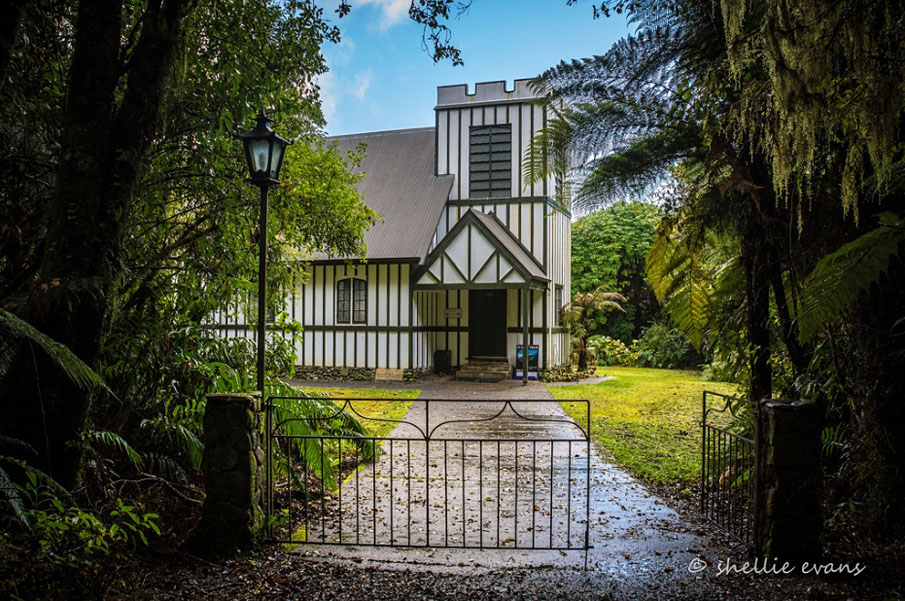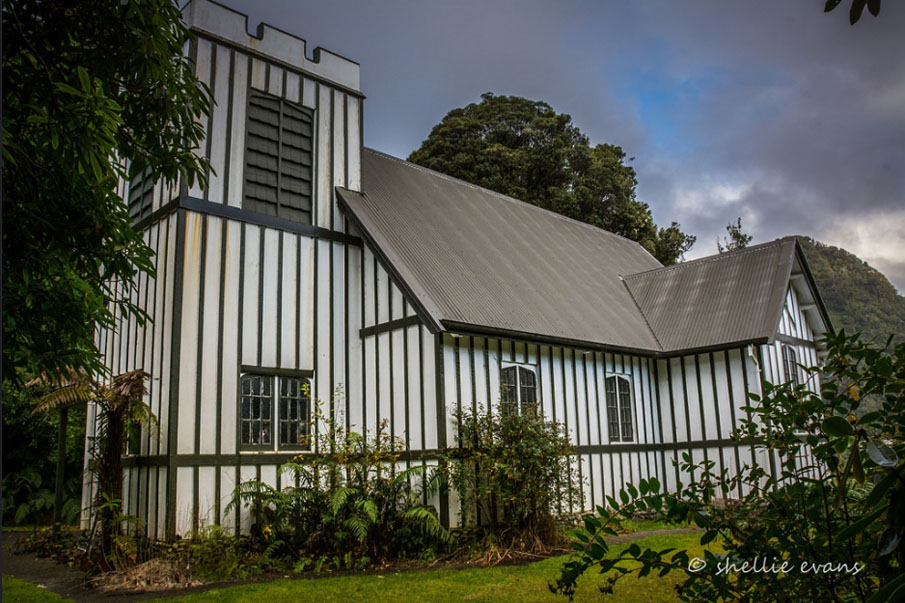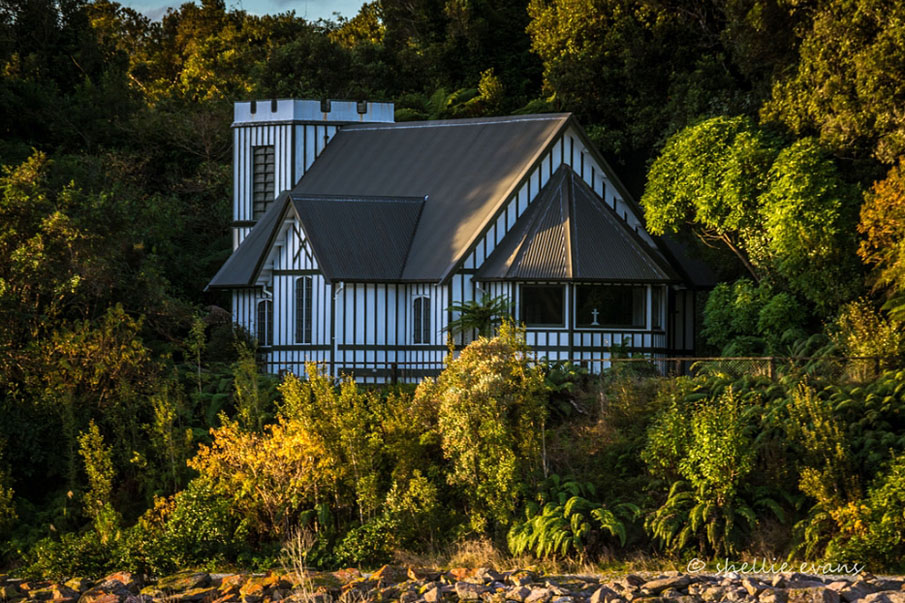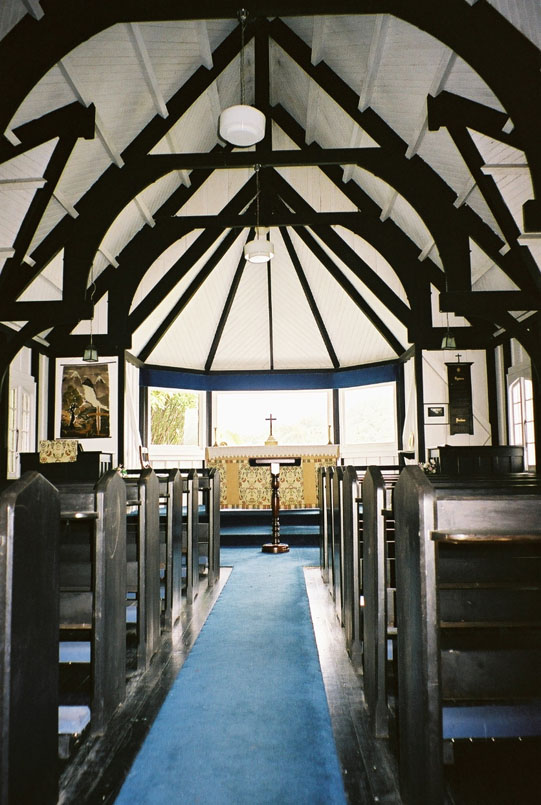The little white and brown church of St James at Franz Josef sits above the banks of the Waiho River and is surrounded by bush. It was designed by architects J.S. Turnbull (1864-1947) and P.W. Rule of Timaru (1888-1953) and built in 1931. Originally known as Waiho, the town of Franz Josef was established as part of the gold-mining rush on the West Coast, but rapidly became dominated by tourists visiting the Franz Josef glacier. The Franz Josef glacier, in conjunction with the Fox further south, are two of the most accessible and low-lying glaciers in the world. By the 1900s groups of visitors were being guided on trips to the glacier and a hotel for the tourist trade had been constructed at Waiho. The Anglican parish of Ross and South Westland had been established as early as 1867, and by 1910 services were being held every second month at a room in Franz Josef. However, due to the small population, a church for Franz Josef was not considered until 1925. The vicar at the time, Reverend James Young suggested that a church be built from the local river stones and Christchurch architect Maurice Guthrie (1891-1968) drew up plans for such a building. This proved too expensive for such a small congregation, which consisted of nine families at the time and eventually new plans were drawn up by Turnbull and Rule. Turnbull was a prominent Timaru architect with a national reputation, who was joined by Rule around 1920. Rule became the firm's chief designer and was noted for his use of a combination of styles and his use of local materials. He was awarded a gold medal by the New Zealand Institute of Architects in 1939 for his design of the Timaru Hospital's Surgical Wing. St James was erected on land donated by local residents and notable mountain guides Peter (1878-1961) and Alexander (Alec) Graham (1881-1957). The Graham brothers were born at Okarito in South Westland and moved to a farm at Waiho (Franz Joseph) after their father died in 1900. Both Peter and Alec became two of New Zealand's most notable early mountain climbers and guides. From 1911 Alec ran the Franz Josef Glacier Hotel in conjunction with another brother Jim and sister-in-law, Rose. He was joined by Peter in 1922 and they ran the hotel for nearly 25 years before selling it to the government in 1947. They were important figures in the township and the hotel also served as post office, community and first-aid centre. As designed by Turnbull and Rule, St James is a little church constructed from board and battens on a boulder and concrete foundation. It combines elements of both Gothic Revival and Arts and Crafts styles, with its gabled roof, clearly distinguished transepts and hexagonal aspe, combined with the paired casement windows of bubbled glass set in Tudor arch frames. The entrance to St James is situated under a square crenellated tower. The battens on the exterior of the church are painted brown, in contrast to the white of the boards. The original plan for the church was somewhat modified by the later vicar, Reverend Warren, who was responsible for the general layout and the blue and white colour scheme of the interior. The church was named St James in recognition of an earlier vicar, James Young, and his services to the community. The dominant feature of St James is the three plate glass windows behind the altar, which predate the more well-known plate glass windows in the Church of Good Shepherd at Tekapo (also registered by the New Zealand Historic Places Trust/Pouhere Taonga). It is said that this idea of framing the natural glories of the world for the congregation to view, rather than installing stained glass windows, was suggested by Archdeacon J.A. Julius (1874-1956) who visited the area in February 1927 and was inspired by the view. At the time the Franz Josef glacier was visible from the church site. In order to incorporate the glacier in the view from behind the altar, the alignment of St James was shifted from the traditional layout where the altar was placed at the east. The church gained national significance when the view from the altar to the mountains was reproduced on the 9d 'Peace' stamp of 1946. The view of the glacier gradually receded and it was totally lost by 1952. However, it returned in 1994. St James has continued to be used as a parish church. A flood in December 1995 washed away a large portion of the bank on which it sits and it was proposed to move it to a different site. However, after much discussion, a flood protection scheme was put in place instead and the church remains on its original site. St James Church at Franz Josef is illustrative of the religious history of small New Zealand communities and their desire for a church of their own. Set in West Coast bush, in an area praised for its natural beauty for centuries, the church is visually appealing. It is an example of Turnbull and Rule's ecclesiastical design, a firm more commonly known for its domestic and commercial work. The use of plate glass windows behind the altar is unusual and, since 1994, again frames a view of Franz Josef glacier. This view came to symbolise peace for New Zealanders when it was reproduced as a postal stamp in 1946. St James is also associated with the Graham brothers, among the more notable mountaineers produced by New Zealand. The church is still held in public esteem and this was clearly demonstrated in the discussion over its removal in 1996.




Location
List Entry Information
Overview
Detailed List Entry
Status
Listed
List Entry Status
Historic Place Category 1
Access
Private/No Public Access
List Number
4994
Date Entered
6th June 1990
Date of Effect
6th June 1990
City/District Council
Westland District
Region
West Coast Region
Extent of List Entry
Extent includes the land described as Lot 1 DP 703 (RT WS2B/1084), Westland Land District, and the building known as St James Church (Anglican) thereon.
Legal description
Lot 1 DP 703 (RT WS2B/1084), Westland Land District
Stay up to date with Heritage this month
